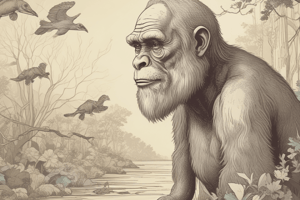Podcast
Questions and Answers
What is evolution comprised of?
What is evolution comprised of?
- Variation
- Selection
- Heredity
- All of the above (correct)
What do Darwin's finches illustrate?
What do Darwin's finches illustrate?
Adaptation based on the size/type of seeds they eat.
What are synapomorphies?
What are synapomorphies?
Shared derived characteristics.
What are autapomorphies?
What are autapomorphies?
What are symplesiomorphies?
What are symplesiomorphies?
What is the difference between synapomorphy and symplesiomorphy?
What is the difference between synapomorphy and symplesiomorphy?
What's the idea of the tree of life?
What's the idea of the tree of life?
What does the picture explain in terms of evolution?
What does the picture explain in terms of evolution?
What is the most parsimonious tree?
What is the most parsimonious tree?
Why is the gamma hemoglobin important before birth?
Why is the gamma hemoglobin important before birth?
What are the scenarios where new genes can arise?
What are the scenarios where new genes can arise?
May proteins with very different functions be born from duplications?
May proteins with very different functions be born from duplications?
Give an example of genetic adaptation.
Give an example of genetic adaptation.
The sickle-cell mutation was under balancing selection in areas where malaria was present.
The sickle-cell mutation was under balancing selection in areas where malaria was present.
What did malaria studies find about AS individuals?
What did malaria studies find about AS individuals?
Study Notes
Evolution
- Defined as the process involving variation, selection, and heredity.
- Inheritance is polygenic; multiple genes contribute to phenotypic traits, not blended inheritance.
Darwin's Finches
- Illustrate adaptation where species modify traits to fit environmental conditions.
- Beak size and shape adapt based on available seed types, showing natural selection at work.
Synapomorphies vs. Other Traits
- Synapomorphies: shared derived characteristics unique to a lineage.
- Autapomorphies: distinct features unique to a specific taxon, not found in others.
- Symplesiomorphies: ancestral traits shared between taxa but do not indicate specific relationships in the evolutionary tree.
Distinctions in Ancestral Traits
- Synapomorphies help define evolutionary relationships; symplesiomorphies do not.
Tree of Life Concept
- Organisms are more closely related if they share numerous derived character states.
Character Evolution
- Nucleotide states evolve; ancestral states (A) and derived states (T) shared among sister branches illustrate synapomorphies.
Most Parsimonious Tree
- Refers to the shortest evolutionary tree, representing the least number of evolutionary changes.
Fetal vs. Adult Hemoglobin
- Fetal hemoglobin (alpha and gamma) has a higher oxygen affinity, aiding oxygen extraction from the mother via the placenta.
New Gene Formation
- New genes may arise through:
- Inactivating mutations leading to pseudogenes, accumulating mutations through genetic drift.
- Mutations altering regulation or function, leading to neofunctionalization.
- Altered regulatory mutations splitting original function, creating complementary paralogs (subfunctionalization).
Functional Divergence Post-Duplication
- Distinct functions can emerge from duplicated genes, illustrated by goat alpha-lactalbumin and hen lysozyme genes.
Genetic Adaptation Example
- Sickle cell anemia exemplifies genetic adaptation in response to environmental pressures.
Sickle-Cell Mutation and Selection
- Balancing selection occurs where malaria is prevalent: AS individuals are favored for resistance while AA and SS genotypes face disadvantages.
Malaria Studies Findings
- AS individuals demonstrate a survival advantage in early life compared to AA and SS individuals due to the sickle cell trait providing some malaria resistance.
Studying That Suits You
Use AI to generate personalized quizzes and flashcards to suit your learning preferences.
Description
Prepare for your Genetics final with these flashcards covering key concepts from Chapter 20. Explore the principles of evolution, adaptation, and heredity through targeted questions and definitions. Perfect for quick revisions!




